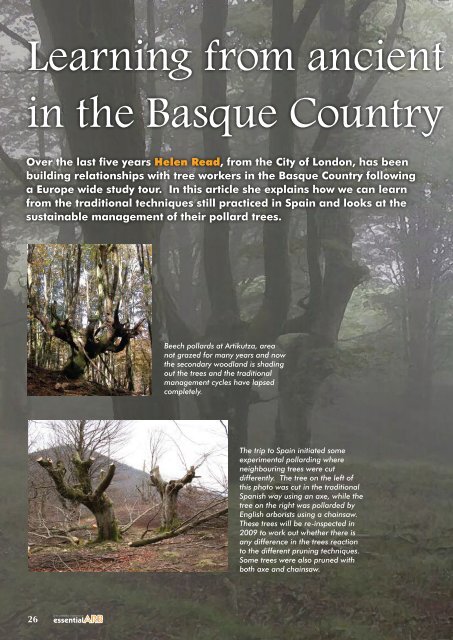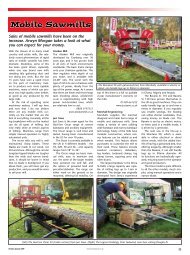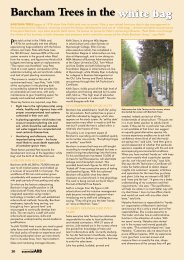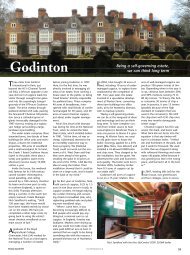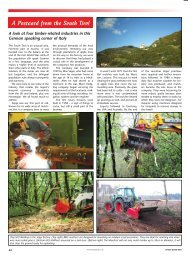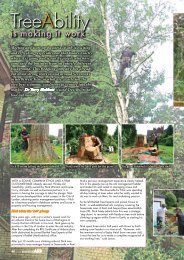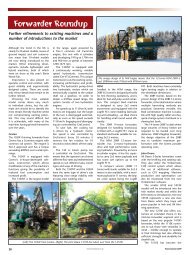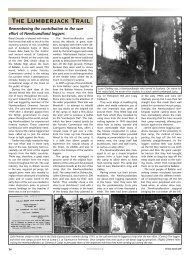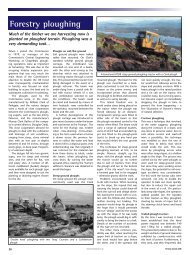Learning from Basque ancient pollards - Forestry Journal
Learning from Basque ancient pollards - Forestry Journal
Learning from Basque ancient pollards - Forestry Journal
Create successful ePaper yourself
Turn your PDF publications into a flip-book with our unique Google optimized e-Paper software.
Over the last five years Helen Read, <strong>from</strong> the City of London, has been<br />
building relationships with tree workers in the <strong>Basque</strong> Country following<br />
a Europe wide study tour. In this article she explains how we can learn<br />
<strong>from</strong> the traditional techniques still practiced in Spain and looks at the<br />
sustainable management of their pollard trees.<br />
Beech <strong>pollards</strong> at Artikutza, area<br />
not grazed for many years and now<br />
the secondary woodland is shading<br />
out the trees and the traditional<br />
management cycles have lapsed<br />
completely.<br />
The trip to Spain initiated some<br />
experimental pollarding where<br />
neighbouring trees were cut<br />
differently. The tree on the left of<br />
this photo was cut in the traditional<br />
Spanish way using an axe, while the<br />
tree on the right was pollarded by<br />
English arborists using a chainsaw.<br />
These trees will be re-inspected in<br />
2009 to work out whether there is<br />
any difference in the trees reaction<br />
to the different pruning techniques.<br />
Some trees were also pruned with<br />
both axe and chainsaw.<br />
26<br />
1
The art of restoring lapsed <strong>pollards</strong><br />
is a new one, necessitated by many<br />
decades or even centuries since<br />
the trees were last ‘working trees’<br />
that were cut for their wood. Sadly<br />
this long lapse, for beech trees in<br />
particular, has meant that we cannot<br />
find people in Britain who pollarded<br />
trees for a living and there is little<br />
information about how to start new<br />
<strong>pollards</strong> or how they were managed<br />
in a regular cutting cycle.<br />
In 2003 I undertook a study tour<br />
across northern Europe in order<br />
to try and find out more about<br />
the technique of pollarding and<br />
especially to try and discover more<br />
about beech <strong>pollards</strong>. The last area<br />
I visited was the <strong>Basque</strong> Country,<br />
which straddles the south west of<br />
France and northern Spain, and this<br />
proved to be the most interesting<br />
and relevant. I was also fortunate to<br />
meet people who have subsequently<br />
become good friends and who<br />
have enabled us to discover more<br />
about their culture and past tree<br />
management practices.<br />
In the <strong>Basque</strong> Country there are<br />
tremendous numbers of beech<br />
<strong>pollards</strong>. In some communities they<br />
were located on common pastures<br />
belonging to the village or town and<br />
were essential for domestic fuel. In<br />
other places, close to the coasts,<br />
there were extensive areas of land<br />
with pollarded trees, the wood <strong>from</strong><br />
27
Feature: <strong>Learning</strong> <strong>from</strong> <strong>ancient</strong> <strong>pollards</strong> in the <strong>Basque</strong> Country<br />
Feature: Article Title<br />
These beech <strong>pollards</strong> at Oieleku<br />
were cut in the past to make<br />
charcoal for use in iron foundries.<br />
Today the land underneath is still<br />
grazed by sheep and ponies.<br />
Pollard cut at Leitza to a charcoal<br />
makers specification in Feb 2007,<br />
with the photograph taken in June<br />
2008.<br />
which was converted to charcoal<br />
and then used to fuel iron smelting<br />
works. Many other special trees also<br />
co-existed with the ‘traditional’ type<br />
of <strong>pollards</strong>. These were trees cut and<br />
shaped for particular pieces of wood,<br />
such as curves and forks, for use in<br />
ship building. The iron and wood<br />
were essential raw materials for the<br />
economically important <strong>Basque</strong> ship<br />
building industry along the coast.<br />
In contrast to the beech trees at<br />
Burnham Beeches, last cut for their<br />
wood around 200 years ago, some<br />
of these <strong>Basque</strong> trees have barely<br />
lapsed. There are also elderly people<br />
who were charcoal makers in their<br />
youth and are still very much alive<br />
and able to describe how the tree<br />
cutting was carried out.<br />
Since my initial visit there has been a<br />
great deal of exchange between the<br />
<strong>Basque</strong>s and various different ‘tree<br />
people’ <strong>from</strong> Britain. Members of the<br />
Ancient Tree Forum in particular have<br />
explored the area and found much<br />
of interest, not only regarding beech<br />
<strong>pollards</strong> but some huge and <strong>ancient</strong><br />
oak trees, ash <strong>pollards</strong> cut for fodder<br />
and some landscapes rich in veteran<br />
trees.<br />
28<br />
A key feature of all the visits has<br />
been the opportunity to talk to<br />
local people, nature conservation<br />
professionals, arboriculturalists<br />
and historians. The benefit of<br />
this has been to raise awareness<br />
of the value of these trees and to<br />
promote appropriate management.<br />
Pollarded trees are so common in<br />
the landscape that most people were<br />
unaware of their importance and<br />
value and therefore did not realise<br />
the European significance of what<br />
they have on their door step.<br />
Coupled with these site based visits,<br />
Ted Green, Neville Fay and myself<br />
have led workshops and given<br />
presentations on the value and<br />
management of <strong>ancient</strong> trees and<br />
many of these have been directly<br />
to arboriculturalists. We have built<br />
good relationships with Trepalariak<br />
– the <strong>Basque</strong> Arboricultural<br />
Association— and have worked<br />
closely with several of their members.<br />
In the summer of 2006 a couple<br />
of <strong>Basque</strong>s came to England and<br />
worked for a few days at Epping<br />
Forest and Burnham Beeches.<br />
Pollards in the <strong>Basque</strong> Country were<br />
traditionally cut with axes and there<br />
is still a very strong axe culture there.<br />
We invited an axe worker so he could<br />
show us more about how he worked.<br />
During the visit we held an ‘open<br />
afternoon’ so that anyone who was<br />
interested could come and have a<br />
look.<br />
Then in February 2007 a group<br />
<strong>from</strong> the City of London, including<br />
five arboriculturalists, spent a week<br />
in the <strong>Basque</strong> Country. They took<br />
their chainsaws with them and<br />
participated in an experiment that<br />
was also intended to highlight the<br />
importance of these trees to local<br />
people. Working alongside <strong>Basque</strong><br />
arboriculturalists <strong>from</strong> Trepalariak<br />
and local people wielding axes, 40<br />
trees were cut in two main locations.<br />
In one area (Oieleku) the aim was to<br />
compare cutting to the specification<br />
of the charcoal makers with that<br />
of the more gradual restoration<br />
techniques we use in England (all<br />
trees being cut with chainsaws)<br />
and some 25km south in the other<br />
area (Leitza) the charcoal makers’<br />
specification was used but some trees<br />
were cut with axes and some with<br />
chainsaws (and a small number half<br />
and half). The traditional method of<br />
cutting requires that almost all the<br />
branches of the pollard are removed<br />
leaving generally quite short stubs.<br />
Small branches were retained but<br />
generally only very thin ones. This<br />
technique is not something we would<br />
3
Feature: <strong>Learning</strong> <strong>from</strong> <strong>ancient</strong> <strong>pollards</strong> in the <strong>Basque</strong> Country<br />
Trees at Leitza cut to the charcoal<br />
makers specification in Feb 2007,<br />
photograph taken at time of cutting.<br />
Tree cut with chainsaw<br />
One year after pollarding this tree<br />
had a few new shoots growing<br />
low down on the branches so it<br />
was scored with an axe to try and<br />
stimulate more growth<br />
consider attempting on old <strong>pollards</strong><br />
in Britain but a small number of trees<br />
cut like this in the years immediately<br />
prior to our work in the <strong>Basque</strong><br />
Country showed good initial growth.<br />
It is interesting that the charcoal<br />
makers were convinced that trees<br />
that we cut as a gentle reduction<br />
would die and most of the British<br />
were convinced that trees cut in the<br />
manner of the charcoal makers<br />
would die! The cutting cycle of<br />
<strong>pollards</strong> in the <strong>Basque</strong> Country seems<br />
to vary. In some places it is similar to<br />
that in Britain but in others a length<br />
of up to 50 years is reported. At least<br />
some of the trees that were worked<br />
on were last cut approximately 50<br />
years ago and so were barely out of<br />
cycle.<br />
In June 2008, midway through<br />
the second growing season after<br />
cutting, a small group of British<br />
people returned to the trees as part<br />
of a longer visit. The following<br />
comments are based on a quick<br />
visual assessment of the trees. At the<br />
location where the cutting with axes<br />
and chainsaws had been compared<br />
the trees all showed new growth,<br />
much of which was good and strong,<br />
and largely in the form of new shoots<br />
<strong>from</strong> the cut branches (something<br />
that is relatively rare in southern<br />
England). Some branches had not<br />
faired so well and there appeared<br />
to be a degree of variation between<br />
trees that did not seem to be related<br />
to the cutting tool used. In contrast,<br />
the trees in the more northerly area<br />
that had been cut hard, were not<br />
growing so well and those cut in a<br />
more gentle way appeared stronger<br />
and healthier. The difference in<br />
response may be related to location<br />
and climate or perhaps the age/<br />
condition of the trees at the time of<br />
cutting. It is planned to return in<br />
2009 to carry out a more detailed<br />
evaluation of the responses of the<br />
trees and hopefully this will be<br />
reported on when we return.<br />
The sheer numbers of pollarded<br />
beech trees in this area enables us to<br />
learn <strong>from</strong> actions and experiments<br />
that we would be unable or unwilling<br />
to undertake in Britain because of the<br />
vulnerability of our remaining tree<br />
populations. In exchange we hope<br />
that our experiences with <strong>ancient</strong><br />
trees have enabled the local people<br />
to view their trees in a different light<br />
and to learn about new techniques<br />
that they have not encountered<br />
previously.<br />
Lapsed Beech <strong>pollards</strong> in the mist<br />
Gorbeia Natural Park<br />
All pictures by Helen Read<br />
294


